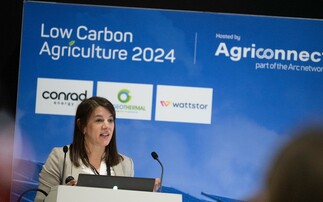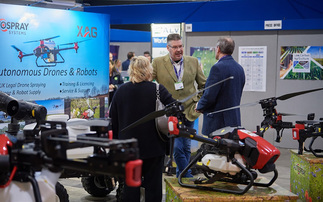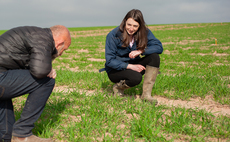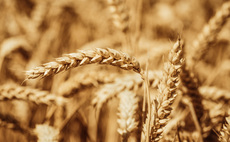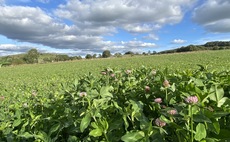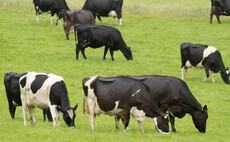
The first day of CropTec 2022 offered a great insight into the latest news and technology in the arable industry. ��ż��� reports.
Higher ELM budget will keep food prices down for consumers
Ploughing more money into Defra’s Environmental Land Management (ELM) scheme will keep food prices down for consumers, according to AHDB technical knowledge exchange manager Harry Henderson.
Mr Henderson said retailers are under immense pressure to limit food inflation and they would always want to push additional costs back on to producers, but Government policies could act as a brake.
Speaking at the ‘coping with change’ seminar at CropTec in Peterborough today, he said: “If there is only one thing you take away from me today, it would be less money coming from the ELM scheme means the consumer will be paying more.
“If more money comes from ELMs, the consumer will not need to pay as much.”
He suggested farmers now had to make a ‘robust business case’ to Ministers to ensure the budget was adequate.
Caroline Nicholls, the Sustainable Farming Incentive (SFI) content team leader at Defra’s Future Farming and Countryside Programme, said more detail would be published on the outcome of the ELM review launched by former Secretary of State Ranil Jayawardena and continued by his successor, Therese Coffey, by ‘the end of the year’.
“We have heard a lot today about how input costs are changing,” she said.
“There are lots of changes in the environment, we are learning a lot from farmers, and what we want to do is make sure we really are taking all these things into account.”
Make the most of free online AHDB Recommended List variety selection tools
��ż��� are being urged to make the most of free online AHDB Recommended List variety selection tools to help minimise disease risk and resistance breakdown.
Speaking on the AHDB stand at CropTec, senior crop protection specialist Catherine Harries explained that growers could easily filter RL variety data for their particular situation and challenges, while the variety blend tool made choosing a mix of appropriate varieties much more straightforward.
While the RL variety selection tool () looks complicated at first glance, she said getting ‘stuck in and using it’ was the best way to approach it. “You can’t break it!”
It allows growers to take a bespoke approach for their farm, she explained. “If one disease is more important on your farm, you can select that and the result will change based on your preferences.” She explained that looking at the ‘least significant difference’ figures for disease ratings would show whether a ratings of, for instance, 6.9 and 5.8 between two varieties was actually of significance or not.
New pea and bean varieties offer stability and reliability
Despite drought conditions and record temperatures throughout the growing season, varieties trialled across the country during 2022 demonstrated good consistency in terms of yields and disease resistance.
Six new combining peas and one new winter bean join the 2023 Descriptive Lists, which were launched at The CropTec Show. A further four new spring bean varieties could be added at a later date, subject to National Listing.
Speaking at CropTec, senior PGRO technical officer Chris Judge said: “High yielding varieties have maintained their good performance and other traits such as disease ratings also retain similar scores to before, with the addition of new supporting data.
“The list now includes a score for downy mildew and rust on winter beans.”
For more info:
The PGRO Descriptive Lists for pulses are available at
The new Recommended List on yellow rust
The new Recommended List – due out shortly – will now show young plant susceptibility to yellow rust, which can be different to that of more mature plants.
Speaking at the AHDB’s stand at CropTec, senior crop protection specialist Catherine Harries said that most variety resistance data for yellow rust is based on adult plants. “But we know that varieties may be susceptible at an early stage, and this has not been shown in RL ratings before.
“The new RL list will show this. It’s based on work with the UKCVPS which tests five races of yellow rust which were prevalent in the previous season.
“Don’t panic if you are seeing yellow rust early in the season, as adult yellow rust resistance will kick in at ear emergence, but if you do see it [at an early stage], control it.”
She said that work was continuing to monitor yellow rust variety resistance breakdown and to improve the prediction of when this might happen. Performance data on the appearance of symptoms from trials sites has been used in data released over the last two years, and so far was giving a good indication of when resistance was starting to break down.
New option for post-emergence weed control in winter wheat
A new option for post-emergence weed control in winter wheat will be available for use in spring 2023.
Based on the mesosulfuron+iodosulfuron ALS actives already available in Atlantis, Atlantis Star from Bayer sees the addition of a third ALS active in the form of thiencarbazone, said to offer improved grass-weed control and control of a wider range of broad-leaved weeds.
The three-way co-formulation is claimed to offer a 5 per cent improvement in control of black-grass and Italian ryegrass and as much as a 10 per cent increase in brome control compared to Pacifica Plus (iodosulfuron+mesosulfuron+amidosulfuron). Cranesbill, charlock, poppy and mayweeds are among the broad-leaved weeds controlled by Atlantis Star.
Speaking at CropTec, Bayer campaign manager Tom Chillcott said the new herbicide is not a resistance-buster but will provide a valuable step-up in control of susceptible weed populations.
He said: “The situation with post-emergence herbicides is complicated by resistance. We know there are fields and farms with grass-weeds, particularly black-grass, where an ALS post-em like Atlantis is not right. But resistance testing shows there still very many places where farmers are using post-ems to good effect.”
Atlantis Star is approved for use in winter wheat between GS13-32 and from February 1.
Low input and productivity can go hand in hand
Productivity versus sustainability is a hotly debated topic in crop production, but Lincolnshire farmer Mark Stubbs, who has won multiple Yield Enhancement Network (YEN) awards said his system is proof the two can go hand in hand.
In the year he transitioned from ploughing to min-till he says yields increased by 0.5 tonnes per hectare, while the introduction of cover crops 10 years ago has helped to bind clay soils together, improve structure and reduce run off.
Speaking during the Water hub, sponsored by Anglian Water he said:“We put the awards we win through YEN down to cover cropping, manures and just getting soil health right. I’m often accused of applying high inputs, but in actual fact it’s the opposite. I’m probably spending much less on chemicals than some other farmers.”
New tech start-up aims to deliver a biodiversity score for individual farms
A new tech start-up aims to deliver a biodiversity score for individual farms which can be used by companies in the same as a credit score is used for individuals.
FarmScore, which is being developed by a company called Agtelligence, is being funded by the UK Space Agency and European Space Agency. It will use satellite data, combined with other sources of available data such as soil type and texture and topography, to produce a biodiversity score for individual farms, explained Nima Eskandari, Agtelligence’s CEO.
“Our customers are companies who want to know which farms are the most sustainable. So, like credit scores, lenders might have a better rate for more sustainable farms, or supermarkets might pay more [for their produce].”
He said the business was keen to work with farmers, and was seeking their views in a survey it was undertaking at CropTec. It is working on its initial prototype, and aims to launch this in March next year. At present, the data is based individual fields rather than farms but this will change as the work progresses.
“Our goal is to encourage UK farmers to move towards sustainable farming systems, and we want them to engage with us and look at how they can boost their sustainability score.”
Water investment needed to tackle food security
With the UK experiencing one of its driest summers on record, the Holkham Estate saw all five of its reservoirs run dry for the first year ever.
Speaking during the Water hub, sponsored by Anglian Water, James Beamish, farm manager at the Holkham Estate in Suffolk said: “We have invested a lot in water storage over the last 25 years, but this was the first time we have ever run dry. The farming investment fund is great in investing in local water infrastructure, but it’s probably national infrastructure we need to be looking at for food security.”
Alice Green, land use and policy adviser at CLA encouraged growers to double check when their water abstraction licenses are up for renewal.
“It is important to know because of changes to licensing occurring in the next few years – make sure you can demonstrate your [water volume] need and make any changes you need to your license.
“Abstraction licenses will probably move into the environmental permitting regime. We haven’t had clarity on exactly how that’s going to work, but we know to expect some quite big changes.”
Mark Stubbs added that greater funding for flood alleviation was needed.
“We need more grant money for clearing ditches. If I clean my ditch, it’s fine but if my neighbour doesn’t have the funds to clear their ditch it creates a dam for me and the water will keep backing up which will affect me and also my neighbour the other side probably even more so.”
Win a research project at CropTec
Up to five projects with a Cranfield MSc student are being offered to CropTec attendees, valued between 5,000 to 8,000 each.
Taught master’s students undertake a thesis project as part of their degree course. Cranfield University seek industry sponsorship for these projects since the benefits to both sides are substantial.
The industry partner commissions a research project tailored to their specific needs, with students supervised by one or more experts in the field, gaining access to a talent pipeline for future recruitment.
The student benefits from applied experiences and opportunities to solve real-life challenges whilst Cranfield University ensures that their teaching remains highly relevant to the needs of industry, something that sits at the heart of Cranfield’s ethos.
The industry partner may choose their level of involvement, from very light touch to part-time hosting of students at their premises (something the students often find very rewarding). The Partner may also provide crucial information, such as access to datasets.
Dr Juliet Kauffmann, business development manager at Cranfield University said: “The competition will be drawn by looking through the project proposals that are the best fit for the university and most exciting for the students.”
Tests to catch latent disease burdens
Diseases such as ramularia, net blotch and rhynchosporium cause significant losses across UK yields.
Part of the challenge with any cereal disease is detection. Treatment at early stages will give the highest chance of success, but if the disease is latent, it will be hard to discover without testing.
SwiftDetect claims to be the fastest and most accurate way to detect and quantify disease in crops. The test requires a sample of 10 leaves to be tested by Microgenetics labs, with results available within one business day.
SwiftDetect has been available for wheat since 2021, testing for diseases from septoria to yellow rust, and for oilseed rape, the first test for light leaf spot test was launched this September and will be followed by tests for phoma and sclerotinia in Autumn 2023.
Samples for light leaf spot are being tested by Microgenetics with reports of primarily low to undetected disease infections. However, over the last few weeks infections have been rising which is thought to be due to the increased rainfall.
Diseases can be identified and treated sooner and could provide an opportunity to delay spray programs if no disease is found.
The ramularia test has already been around for a season, having launched in March 2022. The net blotch and rhynchosporium tests will complete the SwiftDetect barley portfolio.
Technology to create a sustainable nitrogen supply
New technology could help to manage soil-applied nitrogen and achieve net zero.
The spray-on R-Leaf product is based on photocatalysis where light is used as energy to convert nitrous oxides (N2O) to nitrate to create a source of sustainable nitrogen.
The formulation is applied to crops and as it removes N2O from the air, the process creates nitrate as a by-product. Sustainable nitrate is produced with small amounts on each leaf produced daily.
The removal of N2O from the atmosphere bears carbon credits and the R-Leaf has been validated by the Climate Impact Forecast (CIF) tool and supported by the European Innovation Council (EIC) that spraying 2 litres of R-Leaf per hectare on a wheat crop can remove 5.4 tonnes/CO2.
Jeremy Hitchman, commercial manager at Crop Intellect says: “COP 26 created 1,002 tonnes of carbon dioxide. If we used 38,000 litres of R-Leaf over 19,000 hectares we could neutralise the Co2 that was created.”
Crop Intellect is working to register the technology at Gold Standard to issue carbon credits. The technology could contribute to achieving net zero at farm level, enabling additional income streams.
Dr Apostolos Papadopoulos, founder and CEO says: “We need to be accountable for our carbon footprints and this product can be used as a tool to reach net zero.”









